Brolga
BrolgaAntigone rubicunda | |
|---|---|
| Kingdom: | Animalia |
| Phylum: | Chordata |
| Class: | Aves |
| Order: | Gruiformes |
| Family: | Gruidae |
| Status | |
| Australia: | Not listed under EPBC Act 1999 |
| Victoria: | Endangered (FFG Threatened List 2025) |
| FFG: | Listed Action Statement No. 119 (pdf) |
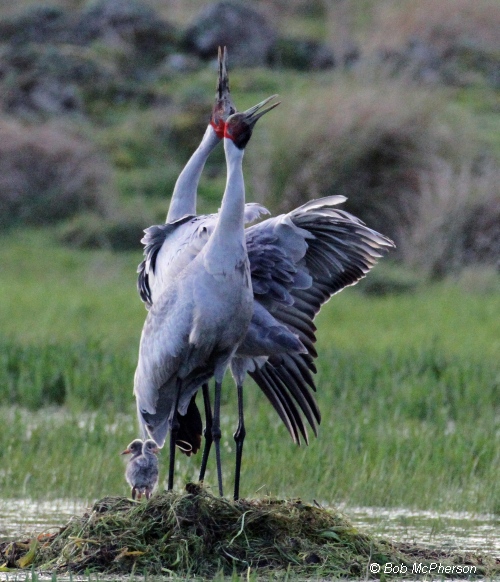
The Brolga Antigone rubicunda, previously (Grus rubicunda) is a light-grey coloured crane, standing about 1.8 metres high, it has a long, straight bill, long dark coloured legs and a wing span of about 2 metres. Appearance changes with age. Immature birds (up to 10 months of age) have a grey, fully feathered head. Juveniles (11 to 22 months) gradually lose their head feathering and attain a pale orange-red head colouring.
Adults have a conspicuous orange-red head, which contrasts with the bare crown of greenish-grey skin and have a black dewlap under the chin. Adult males and females appear similar, although males are larger.
Distribution
Genetic research conducted in 2016 via the Nature Glenelg Trust found a genetic differentiation between the Victorian and northern Brolga populations. It is now considered that the Victorian population should be treated as an independent management unit isolated from the northern populations of brolga.
In Victoria, Brolga numbers are highest in the south-west (907 adult birds in the 2013 count), compared with northern irrigation areas (Est. population 60-70). The higher numbers in the south-west are probably due to higher rainfall and the occurrence of suitable freshwater habitats.
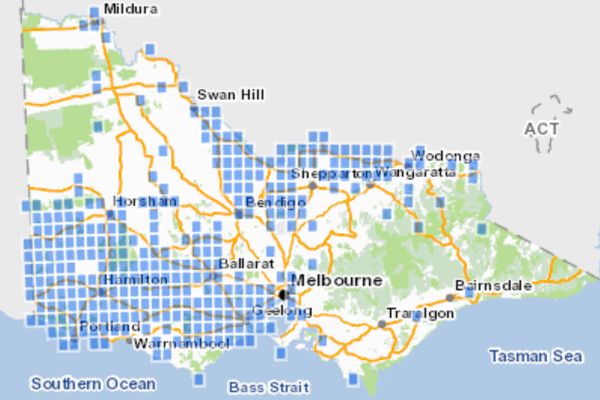
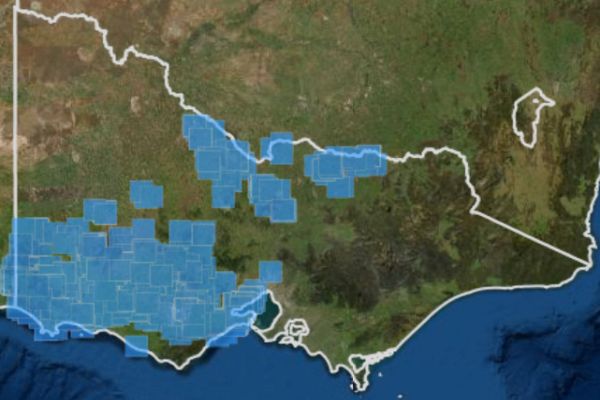
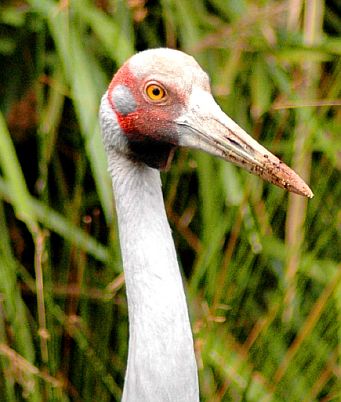
Ecology & Habitat
During the breeding period between July to December the main habitat is freshwater meadows or shallow freshwater marshes, although they have been known to nest in deep freshwater marshes and in the shallows of permanent open water in association with vegetation. During the non breeding period from late December to early May habitat comprises deep freshwater marshes, vegetated areas in permanent open water and feeding areas in pasture, seed and stubble crops. The Brolga is omnivorous and utilises a diverse range of food items on a seasonal basis, including vegetable material, amphibians, sometimes small fish and a wide range of invertebrates, including freshwater molluscs, crustaceans and insects.
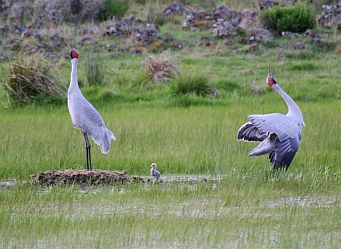
Brolga pair with chick in south west Victoria, September 2016. Footage courtesy Bob McPherson.
Population Status
Brolga flocking counts in south-west Victoria recent history and updates
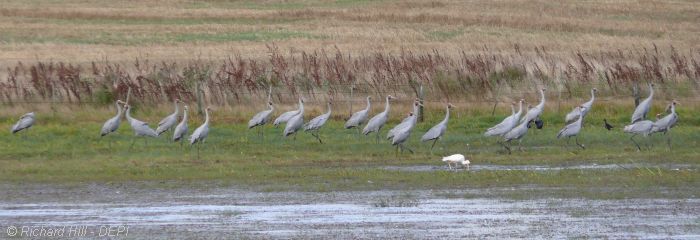
July 2010
Flocking counts were conducted in May 2010 with numbers down on previous counts. A good sign was that 6 out of 8 chick banded the year before were recorded in the flocking counts.
This year eight chicks have been colour banded (2 in the Skipton, 4 in the Darlington/Derrinallum/Mortlake and 2 in the Minhamite areas). Two individuals from the Willaura area have been colour-banded and fitted with satellite transmitters. These birds are currently in the Digby/Dartmoor area. Two individuals at Penshurst have also been colour-banded and one of these has a satellite transmitter. One bird has travelled 125 km.
2011 / 2012
Flocking counts were conducted in May 2011 with numbers similar to previous counts considering the count did not include all known sites. The flocking counts of 2011 indicated a positive sign of 50 young birds (1 & 2 year old). The largest flocking sites were at Penshurst with up to 121 birds recorded and Kaladbro Swamp with 76 birds.
With high rainfall over the last two years many wetlands have been replenished and it is hoped the 2012 breeding season will be a success.
Michelle Casanova, Botanist, Royal Botanic Gardens, Melbourne has undertaken a study to examine the effect of cropping on swamps (Casanova 2012). She found that the flora (community of water plants) that establishes when swamps wet-up after cropping is different from swamps that were not cropped. Cropped swamps have more species that respond to disturbance, a lower plant density and fewer perennial grass species. The seed bank of cropped swamp samples was different from the seed banks of uncropped swamp samples with fewer species and less dense vegetation. Cropping swamps reduces their capacity to respond to water when wetter seasons occur which is likely to affect the quantity and quality of Brolga habitat in the landscape.
2013
Information provided by Richard Hill, DELWP, Casterton
In late April this year, observers again spread out across south-west Victoria to count brolgas at their annual flocking sites. The count had two aims: to get a better estimate of total population size, and to estimate the proportion of young birds in flocks to give an idea of the amount of successful nesting that had occurred in the previous two years. Young brolgas can be aged with confidence to about 2 years old.
Counters searched previously known flocking sites in the following areas: Willaura, Penshurst, Lake Bolac, Streatham, Darlington, Camperdown, Strathdownie, and Bool Lagoon. Bool Lagoon near Naracoorte in South Australia was included because brolgas are known to move between south-west Victoria and South Australia.
A total of 907 birds were counted on the day. The largest flock recorded on the day was a massive 320 birds at Strathdownie counted by Richard and Ros Collins. Numbers for Penshurst were also high, down from a maximum count of 268 earlier in the season to 241 on the count day. A flock of 100 birds were counted at the Willaura flocking site.
The first estimate of the Victoria brolga population was 600-650 birds by Arnol et al. (1984) with approximately 550-600 birds in south west Victoria. The smallest total reported in previous flock counts in south-west Victoria was 402 by Philip Du Guesclin in 2002, and the largest was 675 from 2004 by Rebecca Sheldon. This is only the second year in which counts have been undertaken systematically by having different sites counted on the same day across the state. Previous counts from the late 1980s to 2000s are thus not comparable to the counts from 2012 and 2013. Nevertheless, the large number of young birds in flocks in the past three years and highly unusual sightings of several flocks of sub-adult Brolgas during the breeding season of 2012 both support the conclusion that there has been a substantial increase in total brolga numbers in south-west Victoria in this period.
Large numbers of juveniles and sub-adults were found in this year’s counts, with an estimated 17% of all birds counted being either juvenile or sub-adult (less than two years old). This number is at the upper end of values found for south-west Victorian flocks and is similar to last year’s result. Such high proportion of juveniles and sub-adults in flocks also suggests that breeding success has been higher over the past two years than in previous years. In contrast, the count in 2009 recorded a proportion of only 3% birds less than two years old in counted flocks. These age structure counts are helping us gain a better understanding of breeding success in the southwest and in the longer term, the viability of this south-west Victorian population.
This year all counts were done on a single day, following the advice of Inka Veltheim, PhD candidate at University of Ballarat, who has found that flocking brolgas can move quickly between flocking sites. A simultaneous count of sites across the region gives greater confidence that the number did not include any individuals counted twice. Although the vast majority of birds are considered to flock to these traditional sites, some brolgas can be resident year round at their breeding wetland if they retain water and food resources. Breeding sites are not counted in annual flock counts, and thus these counts represent an underestimate (presumed small underestimate) of the total population size in south-west Victoria.
In conclusion, these counts are allowing us to produce a more accurate picture of the population size and status of our iconic brolga population. Recent results showing substantial increase in successful breeding suggest that breeding success is markedly increased in years of good winter-spring rainfall, and that securing or improving wetland filling for brolga nest sites should be a key focus of brolga conservation in south-west Victoria.
2015
Brolga flock count in south-west Victoria 2015 - Information provided by Department of Environment, Land, Water and Planning, Barwon South West Region.
In late April this year, ecology student and PhD candidate with Federation University Inka Veltheim, and DELWP Senior Biodiversity Officer Richard Hill, visited key Brolga flocking sites in south west Victoria. The objective was to determine the proportion of juvenile and sub-adult birds within the flocks to provide an estimate of the amount of successful breeding that had occurred in the previous two years. This work has been undertaken annually since 2009.
Large flocks of Brolgas were found at regular sites at Strathdownie west of Casterton, north-east of Penshurst, south of Willaura, Darlington, and Lake Wongan while surveys in South Australia failed to detect any flocks.
A total of 449 birds were observed on the one day. The largest flock recorded was of 130 birds north of Penshurst. Of the 449 birds observed, ten percent were juveniles (birds born in spring 2014) or sub-adults (birds born in spring 2013).
In 2014, seven percent of flocks contained juveniles or sub-adults. The lowest estimate since the counts began was three percent in 2009, while in 2012 seventeen percent of flocks were sub-adults or juveniles.
These age structure counts are useful in gaining a better understanding of breeding success in the south-west Victorian population and are considered a better indicator of long term population trends than annual population size estimates.
From these results we are slowly building up a better picture of the population trend and status of our iconic Brolga population and the factors that influence breeding success. This will help in making better informed decisions for their conservation in the future.
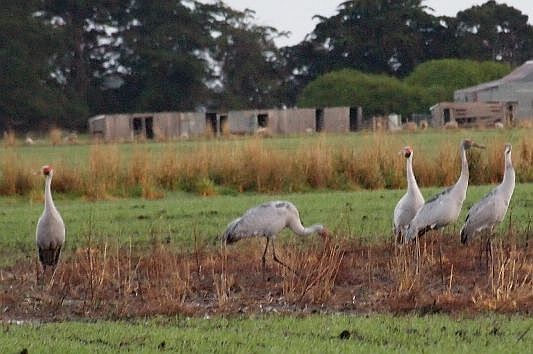
Brolga with chick near Casterton, Victoria. September 2016. Footage courtasy Bob McPherson.
2016 & 2017
Brolga breeding success counts in south-western Victoria 2016 and 2017, information provided by the Department of Environment, Land, Water and Planning, Barwon South West Region.
In late April 2016 and again in 2017, experienced counters visited the main brolga flocking sites in south-western Victoria. The purpose of these visits, which have been repeated annually since 2008, is to estimate the amount of successful breeding and recruitment that has occurred in the previous two years by documenting the proportion of juvenile and sub-adult birds in the flocks.
In 2016, a total of 348 birds were detected on one day. From a subset of these birds where age structure could be determined, 8% were juveniles or sub-adults. In contrast in 2017, the estimate of recruitment was taken from 278 birds, with 18% of birds being juveniles or sub-adults. The contrast in these two results is consistent with the belief that rainfall is a major driver of breeding success with the 2016 breeding season being a very wet year with many wetlands filling and holding water throughout winter, spring and into early summer.
Of particular note from these counts was the very large flock of 373 birds recorded in the Strathdownie/Mingbool area on the Victorian/South Australian border the day before the 2016 count. Due to logistical issues this site could not be visited on the day of the formal count.
2018
Victorian brolga census 2018. Source: Department of Environment, Land, Water and Planning, Barwon South West Region.
On 14 April 2018, observers spread out across Victoria and south-east South Australia to count brolgas at their summer-autumn flocking sites. The count this year had two aims: to get an estimate of the population size through a population census, and to estimate the level of successful breeding from the previous two years through the proportion of young birds counted.
Estimating population size is difficult in nomadic species that range over large geographical areas such as brolga. This is because these species tend to be hard to detect i.e. may be dispersed over numerous locations, and hence large portions of the population may not be counted in one census. This has been evident in the large fluctuations in estimated brolga population size from censuses in the past. The results from a population census are therefore only a ‘snap-shot’ of the population at the time of the count.
This year a team of 15 experienced counters searched known brolga flocking sites in south-western and north Victoria and south-east South Australia including: Willaura, Penshurst, Lake Bolac, Streatham, Darlington, Camperdown, Strathdownie, Bool Lagoon, Rutherglen, Nagambie and Corop.
Unfortunately, 14 April was most memorable for its terrible weather, as a very intense cold front drove very strong winds and heavy rain across south-east South Australia and Victoria. Brolga flocks which had been reported regularly just prior to the count vanished or fragmented and the count results suffered. For example, 150 birds had been reported from Penshurst, but only 54 were found on the day. One hundred and fifty-seven birds were then detected at the same site in the week following the census. Similarly, a reported flock of 100 birds at Bool Lagoon disappeared on the census day, with only six birds detected. The weather also made visibility to see brolgas poor and access at some sites difficult.
In total 377 birds were counted on the day. This figure is well below the last population estimate recorded, however it’s also below or similar to the total birds counted in recent annual recruitment counts, which are only taken from a subset of flocking sites in south-western Victoria (449 birds in 2015 and 348 in 2016). The best explanation for this small population estimate is that the very poor weather meant that many birds were not detected on the day. Poor weather, particularly rain and wind, are recognised factors that impact and reduce detectability during monitoring for many types of birds and hence the outcome here is not surprising.
The results of the breeding estimate (taken from a subset of birds counted where the counter was experienced and confident of identifying different age groups) from the day were encouraging with 13% (32 out of 247) of birds either juveniles or sub-adults (less than two years old). This figure is a relatively high value for Victorian flocks, suggesting that there has been good breeding success over the past two years.
In conclusion, although the population estimate was much lower than expected, it isn’t evidence of a significant reduction in population size, but rather a direct result of the very poor weather. As such, the population census will be repeated in autumn 2019. The positive news from this count is that the Victorian brolga population appears to have again had good breeding success.
2019
Victorian brolga census 2019. Source: Department of Environment, Land, Water and Planning, Barwon South West Region.
Following the horrendous windy and wet weather that marred the 2018 census, observers spread out across Victoria and south-east South Australia on the 6th April 2019 to count Brolgas at their summer-autumn flocking sites. The count had two aims; to get a better estimate of total population size, and to estimate the proportion of young birds to give an idea of the amount of successful breeding that had occurred in the previous two years.
Counters searched previously known flocking sites including but not limited to the following areas: Willaura, Penshurst, Lake Bolac, Streatham, Darlington, Camperdown, Strathdownie, and Bool Lagoon. A total of 635 birds were recorded on the day. Counters recorded numerous flocks ranging from pairs through to the largest flock of 159 birds in the Willaura area, closely followed by 157 at Bool Lagoon. Small numbers of birds were recorded as far east as Lake Weering near Cressy, with bigger flocks south of Streatham and near Penshurst. No birds were found at Lake Bolac, perhaps because of the very dry season and drying out of important shallow swamps birds need for night roosting. No birds were found at Strathdownie on the border with South Australia, an area that has supported up to 300 birds in previous years. It is possible that birds were missed in this area on the day, as the area is characterised by large properties, some of which could not be accessed. A flock of 60 birds was found in this area four days later. Although recorded on the preceding day (5th April 2019) and not included in the overall total, an additional 37 birds were present in the small northern population in the Kerang region.
In addition to overall bird numbers, counters were asked to identify juvenile and sub-adult (less than two-year-old) birds. Only 6% (33 out of the 517 birds which could be allocated into specific age classes) of birds counted were juvenile or sub-adults. This figure is at the lower end of estimates for Victorian flocks and is well below last year’s result of 13%. This suggests that breeding success and/ or survivorship in the past year has been poor. In western Victoria, the 2018 season commenced well with average rainfall through winter, however spring rainfall was significantly below average followed by the warmest summer on record (BOM 2019). These conditions are likely to have led to less wetland filling and duration of filling, both of which impact breeding success, and possibly juvenile survival.
Based on this year’s census the population spanning Victoria and south-east South Australia was at least 635 individuals, with low numbers of young birds suggesting low breeding success in 2018.
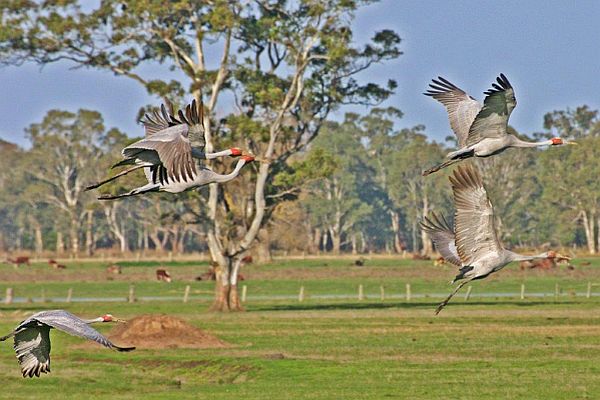
Brolgas in flight across farmlands in south-west Victoria make an impressive sight. Image: Bob McPherson.
2020
Unfortunately, due to the public health measures in place across Victoria due to coronavirus (COVID-19), the 2020 Autumn Brolga count was not able to be conducted.
The annual count at key flocking sites relies on experienced volunteers and DELWP’s priority was to ensure the health and safety of our staff and volunteers.
DELWP thanks our dedicated volunteers and look forward to conducting the counts again in 2021 when safe and appropriate to resume operations.
2021
On the 27th March 2021, experienced counters visited a sub-set of the main brolga summer-autumn flocking sites in south-western Victoria. The purpose of the visits this year were to estimate the proportion of young birds within the flocks to give an estimate of successful recruitment that had occurred in the previous two years.
The known flocking sites around Willaura, Penshurst, Lake Bolac, Streatham, Darlington, Camperdown, Cressy, and Strathdownie were targeted. A total of 413 birds were observed on the day. Counters recorded a total of eight flocks, the largest of 160 birds was found near Penshurst. Small numbers of birds were recorded as far east as Cundare Pool near Cressy.
A very exciting record was the 121 birds at Green Swamp near Dunkeld, which Nature Glenelg Trust (NGT) has been restoring since 2014. Since restoration of water flows four years ago, the numbers of brolgas using Green Swamp during the flocking season has slowly grown. This year it appears that most birds from the traditional Willaura flocking site, just to the north-east, were using Green Swamp. A total of 161 brolgas were counted at Green Swamp by NGT two weeks after the count.
Another significant record was that of a colour-banded bird sighted at Lake Bolac. The bird was originally banded near Skipton as a 6–8-week-old chick. It was approximately 10 years and 6 months old on the day of the count. This individual has been resighted several times, with the last observation being 2019.
Of the 413 birds recorded on the day, 9% were either juveniles or sub-adults (less than two years old). This figure is at the lower end of recruitment estimates for Victorian flocks and suggests that breeding success and/ or survivorship in the past two years has been relatively low.
Source: Department of Environment, Land, Water and Planning, Barwon South West Region.
2022
On the 23rd April 2022, experienced counters again visited a sub-set of the main brolga summer-autumn flocking sites in south-western Victoria. The purpose of the visits was to estimate the proportion of young birds within the flocks to give an estimate of successful recruitment that had occurred in the previous two years.
Flocking sites around Willaura, Penshurst, Lake Bolac, Streatham, Darlington, Cressy, and Strathdownie were targeted. A total of 552 birds were observed on the day. Nine large (>10 birds) flocks were encountered, the largest of 208 birds was found at Green Swamp, Willaura. Small numbers of birds were recorded as far east as Cundare Pool near Cressy. With large numbers of birds recorded at Green Swamp for a third year following the wetland reinstatement by Nature Glenelg Trust and partners in 2014; this has now become very important flocking season brolga habitat. A fabulous result!
Of the flocks where juveniles could be identified (out of 495 birds), 14% were young birds. This figure is towards the higher estimates for south-western Victorian flocks (average for the past 15 years is about 11%) and suggests that breeding success and/ or survival of young birds has been good in the past two years.
Source: Department of Environment, Land, Water and Planning, Barwon South West Region.
2023
On the 22nd April 2023, experienced Brolga counters again visited a sub-set of the main Brolga summer-autumn flocking sites in south-western Victoria. The purpose of the visits was to estimate the proportion of young birds within the flocks to give an estimate of successful recruitment that had occurred in the previous two years.
Flocking sites around Willaura, Penshurst, Lake Bolac, Streatham, Darlington, Cressy, and Strathdownie were targeted. A total of 521 birds were observed on the day. Five large (>10 birds) flocks were encountered, the largest of 195 birds was found near Willaura. Small numbers of birds were recorded as far east as the Werribee Treatment Plant where 11 birds were observed, including four young birds.
Of the flocks where young birds could be identified (out of 304 birds), 14% were young birds (less than 2 years old). This figure is again towards the higher estimates for south-western Victorian flocks (average for the past 15 years is around 11%) and suggests that breeding success and/or survival of young birds has been good in the past two years. The mild summer and good autumn rain this year has already led to flooding of some seasonal wetlands and suggests we might see another good breeding season in 2023.
Source: Department of Energy, Environment and Climate Action, Barwon South West Region.
2024
On the 24th March 2024, experienced Brolga counters once again visited all known Brolga summer-autumn flocking areas in south-western Victoria. The purpose of the visits was to count the young birds within the flocks to give an estimate of successful breeding that had occurred in the previous two years. In addition, this year we attempted to find all flocks of brolgas to provide an estimate of the total population size in Victoria.
Counters visited flocking areas at Willaura, Penshurst, Lake Bolac, Streatham, Darlington, Cressy, and Strathdownie. A total of 836 birds were found in Victoria. Eleven large (>10 birds) flocks were found, the largest of 198 birds was near the South Australian border at Strathdownie. Small numbers of birds were recorded as far east as the Werribee Treatment Plant where 11 birds were seen. Boole Lagoon, just over the border near Naracoorte, is also visited each year on the same day. This year there were 43 birds there making a total of 879 brolgas counted on the day.
The largest count of Brolgas in Victoria was 860 in 2013 but this count was done over two consecutive days. In 2013 we had had two La Niña years of milder temperatures and higher spring-summer rainfall. Those flocks were made up of about 17% young birds less than two years old. On that count weekend in 2013 there were also 47 birds at Bool Lagoon.
Of the flocks in 2024 where they could be identified, 19% were young birds (less than 2yo, from 586 birds). This figure is at the higher end of values for Victorian flocks (average for the past 15 years is 13%) and suggests that breeding success and/ or survival of young birds has been good in the past two years. This higher breeding success, as in 2013, coincides with several years of La Niña conditions.
Three banded birds were also seen. Blue above Blue (a bird with two blue bands on its leg) was seen at Lake Wongan. It is at least 14.5 years old. Orange above Blue (13.5 years) was seen at Lake Bolac, and Orange above Orange was seen at Lake Gellie (18 months old). Please note that sightings of banded brolgas can now be reported to brolga@deeca.vic.gov.au. Please provide a detailed location as well as the colour and position of the two-coloured bands (eg Orange above Red).
Source: Department of Energy, Environment and Climate Action, Barwon South West Region.
Threats
One of the major threats is loss of freshwater habitats through drainage and removal of wetland vegetation. The cropping of swamps has been shown to result in a reduced diversity and density of plants compared with uncropped swamps (Casanova 2012). At a landscape level the widespread cropping of swamps could reduced the quantity and quality of Brolga habitat in the landscape.
Changes in climatic conditions which result in less wetland filling and duration of filling, both of which impact breeding success, and possibly juvenile survival.
The Red Fox is a serious predator, taking eggs and killing chicks. Failure to achieve sustainable levels of recruitment through constant mortality of young Brolgas could have serious impacts for the population in Victoria.
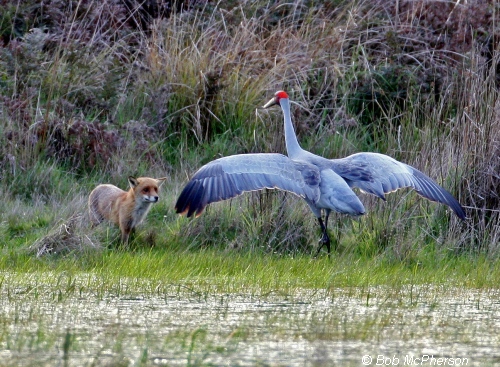
Conservation & Management
The conservation status of the Brolga was re-assessed from Vulnerable in 2013 (DSE 2013) to Endangered in 2021 – Flora and Fauna Guarantee Act Threatened List Victoria (DELWP 2021) and remains Endangered (FFG Threatened List 2025).
The small (200-250 breeding pairs) in the Victorian population is considered to be an isolated and self-recruiting breeding unit but likely to be particularly prone to loss of genetic diversity and the negative effects of inbreeding.
Conservation efforts in Victoria should be geared toward securing and restoring suitable wetland habitats, increasing local population sizes, and preserving genetic diversity.
The protection of wetlands, particularly on private property is crucial in retaining suitable breeding habitats. This includes predator control around and on public and private land which are breeding areas. Improved management of grazing on public wetlands will ensure habitat is retained at Brolga breeding sites. Surveys to determine population trends, identification of nest sites and breeding success are necessary to monitor the population.
Breeding success is highly dependent upon the availability of suitable habitat. Drought conditions combined with a more permanent loss of wetlands due to drainage may have been major contributing factors low breeding success in 2005 when only a handful of nests were counted in south-west Victoria and the success of these in doubt. Results from the 2006 and 2008 flocking surveys in south-west Victoria also found poor recruitment with no immature birds being identified in these years.
Since 2010 there has been an improvement in the number of nests and evidence of young birds in the flock e.g. 50 young (1& 2 year old) birds recorded in 2011. In addition there is evidence the total flock count has risen since 2007 when the south-west Victorian population count was in the order of 600-700 birds compared with the 2013 count of 907 adult birds. The increase could be due to successful breeding, improved counting methodology or movement of Brolgas from adjoining areas in South Australia, therefore some caution needs to be applied when evaluating the overall status of the population.
The 2019 census suggests breeding success and/ or survivorship in the previous year was poor with unfavourable climatic conditions being a factor.
The Brolga Recovery Group was formed in March 2010 and is supported Birdlife Australia, Trust for Nature, Glenelg Hopkins CMA and Greening Australia. It also has connections with people from Universities, and the Department of Environment, Land, Water & Planning.
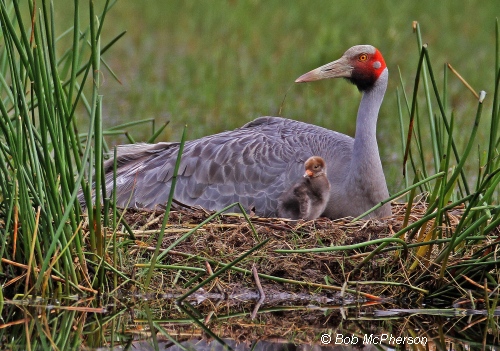
Brolga management actions
Department of Environment, Land Water & Planning
- DELWP plays a lead role in co-ordinating Brolga conservation across Victoria:
- Liaison with other agencies/organisation (e.g. Victorian Farmers Federation, Greening Australia and Catchment Management Authorities) regarding brolga conservation.
- Establishing appropriate grazing regimes and review grazing licences on public wetland areas containing Brolga breeding sites.
- Including Brolga breeding and flocking sites in planning overlays for local government planning schemes.
- Undertaking surveys during the breeding season to locate nest sites, describe nesting habitat, document annual breeding dates (nesting, egg laying, hatching and fledging) and to determine the success of a minimum of 20 nests annually.
- Count the number of adult, juvenile and first year birds at flocking sites each year.
Parks Victoria
- Implement predator control around and on Parks Victoria wetlands which are Brolga breeding areas.
- Encourage predator control by landowners/Landcare groups around Brolga breeding wetlands.
Corangamite CMA area
- Greening Australia through its Victorian Environmental Partnerships Program (VEPP) has a project to liaise with private landholders in the Corangamite CMA to encourage predator control by landowners/Landcare groups around breeding wetlands.
- Brolga habitat will be restored in the Corangamite CMA area though the construction of 8km of fencing and encourage the restoration of shallow and deep freshwater wetlands to increase potential breeding sites. These sites will also be enhanced through the addition of 4ha of revegetation with indigenous species area the wetlands over a 2 year program.
North East Victoria
- Harston Landcare Group has secured grant funding and contracted a controller to instigate a baiting program over a 3 years (2012- 2015). Goulburn Valley Water has engaged a contractor for Murchison Waste Water facility. Parks Victoria has supported fox control in the Wallenjoe-One Tree area. Broken Boosey Conservation Management Network and Whroo Conservation Management Network.
- Flocks of 22 birds recorded 2011/12 and 24 birds in 2012/13 in the Little Wallenjoe area.
- Surveys are undertaken during the breeding season to locate nest sites, describe nesting habitat, document annual breeding dates (nesting, egg laying, hatching and fledging) and determine the success of a minimum of 20 nests annually.
Goulburn Broken CMA area
- The Winton Wetlands have returned to more natural flow regimes and water levels after the decommissioning of Lake Mokoan in 2009. Brolgas have been recorded in the Bill Friday Swamp area. Other areas of the Winton Wetlands system also provide potential habitat including Ashmeads Swamp, the fringes of Winton Swamp and Greens Swamp, and adjacent paddocks of former farmland.
-
A new 5-year research project in the Goulburn Broken catchment commenced in 2024, involving the capture and tagging of 5 brolgas each fitted with a solar-powered GPS/GSM tracking device. The project is hoping to find out more on Brolga movements across the Goulburn Broken catchment landscape and also identify any important breeding areas.
The project is a collaboration between ARI, Biosis and the Goulburn Broken Catchment Management Authority and funded by the Wetland Monitoring and Assessment Program for environmental water WetMap Assessing wetland response to water for the environment (ari.vic.gov.au)
North Central Victoria
- A partnership involving North Central CMA, DEECA, Parks Victoria and landholders is undrtaking predator control on public land surrounding wetlands that Brolga's utilise. Hird & Scotts swamp are priority breeding sites.
- The Kerang wetlands enhancement program will provide valuable Brolga habitat.
- Extensive surveys were conducted over the spring/summer period 2012/13. Brolga's attempted to breed and were unsuccessful at Hird Swamp.
Report sightings of banded brolgas
e-mail detailed location as well as the colour and position of the two-coloured bands (eg Orange above Red) to brolga@deeca.vic.gov.au
References & Links
- Casanova M.T. (2012) Does cereal crop agriculture in dry swamps damage aquatic plant communities? Aquatic Botany 2012.
- FFG Threatened List (2025) Flora and Fauna Guarantee Act 1988 - Threatened List - March 2025, Department of Energy, Environment and Climate Action (DEECA) , Victoria.
- FFG (2025) Victorian Flora and Fauna Guarantee Action Statement No 119: Brolga, Grus rubicunda, 2025. Department of Energy, Environment and Climate Action (DEECA) , Victoria.
- Department of Conservation, Forests and Lands (1984), Management of Brolga in Victoria, Technical report series No 5.
- VVB (2022) Visualising Victoria's Biodiversity

